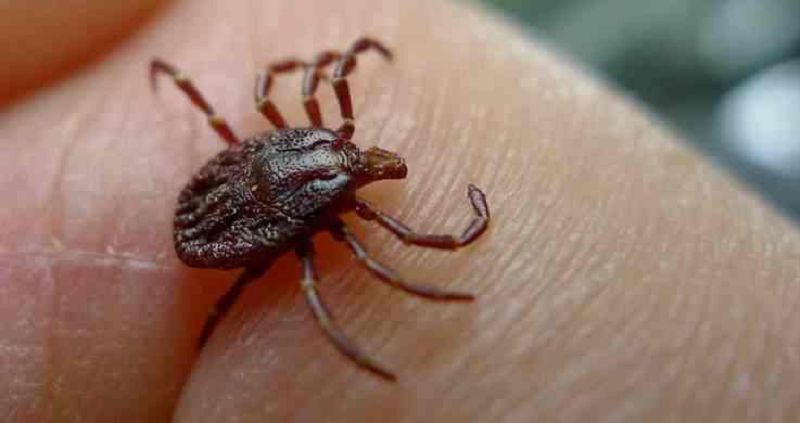
Is it transmitted by deer? Why is it called Lyme disease? Why are there so many different symptoms of Lyme disease? Find out all of this and more.
Is it transmitted by deer? Why is it called Lyme disease? Why are there so many different symptoms of Lyme disease? Find out all of this and more.

Where did the name "Lyme disease" come from?
The town in Connecticut where it was discovered
The common name for the bacteria that cause it
The common name for the ticks that transmit it
The last name of the scientist who discovered it
Answer: The town in Connecticut where it was discovered.
Lyme disease is named after the town, Old Lyme, Connecticut in the Northeastern United States. In the 1970's, two mother's reported to the US government that there was an unusually high rate of juvenile rheumatoid arthritis in their neighborhood. 10 years later, it was discovered that the cause of this arthritis was bacteria that was transmitted by ticks to the children in their neighborhood.
Answer: The town in Connecticut where it was discovered.
Lyme disease is named after the town, Old Lyme, Connecticut in the Northeastern United States. In the 1970's, two mother's reported to the US government that there was an unusually high rate of juvenile rheumatoid arthritis in their neighborhood. 10 years later, it was discovered that the cause of this arthritis was bacteria that was transmitted by ticks to the children in their neighborhood.
Answer: Bacteria
Lyme disease is the general name for the symptoms that result in humans who are infected with "Lyme disease bacteria." These bacteria are called spirochetes because of their corkscrew shape (see photo). Specifically, Lyme disease is caused by many closely related species that are referred to as Borrelia burgdorferi sensu lato. Roughly, this means "Borrelia burgdorferi in the loose sense." The first species to be named in this group is called Borrelia burgdorferi sensu stricto ("in the strict sense").
Answer: Bacteria
Lyme disease is the general name for the symptoms that result in humans who are infected with "Lyme disease bacteria." These bacteria are called spirochetes because of their corkscrew shape (see photo). Specifically, Lyme disease is caused by many closely related species that are referred to as Borrelia burgdorferi sensu lato. Roughly, this means "Borrelia burgdorferi in the loose sense." The first species to be named in this group is called Borrelia burgdorferi sensu stricto ("in the strict sense").
Answer: 20+
The Borrelia burgdorferi sensu lato (s.l.) species complex has 23 genospecies, at least 5 of which result in Lyme disease symptoms in humans. A species complex is a term used for a group of species that are very similar, and that used to be considered one species. In the 1980's, all 23 species of Borrelia burgdorferi s.l. Were called one species. By the 1990's there were ~10 accepted species, and since the 2000's there are now ~20 accepted species.
Answer: 20+
The Borrelia burgdorferi sensu lato (s.l.) species complex has 23 genospecies, at least 5 of which result in Lyme disease symptoms in humans. A species complex is a term used for a group of species that are very similar, and that used to be considered one species. In the 1980's, all 23 species of Borrelia burgdorferi s.l. Were called one species. By the 1990's there were ~10 accepted species, and since the 2000's there are now ~20 accepted species.

On which continents has Borrelia burgdorferi s.l. Been found?
North America
Central America
South America
Africa
Europe
Asia
Australia
Answer: North America, South America, Africa, Asia, and Europe
Borrelia burgdorferi s.l. Has been found on almost all continents of the world! In particular, it is most commonly considered a disease of the Northern Hemisphere. Most species are found at temperate latitudes in North America, Europe, and/or Asia.
Answer: North America, South America, Africa, Asia, and Europe
Borrelia burgdorferi s.l. Has been found on almost all continents of the world! In particular, it is most commonly considered a disease of the Northern Hemisphere. Most species are found at temperate latitudes in North America, Europe, and/or Asia.
Which of the following are symptoms of Lyme disease in humans?
0%
0
0%
0
0%
0
0%
0
0%
0
Answer: Erythema Migrans, Lyme carditis, Lyme arthritis, Neuroborreliosis, and Acrodermatitis Chronica Atrophicans
Different genospecies of B. Burgdorferi s.l. Are responsible for different clinical manifestations of Lyme disease in humans. It is possible that a person with Lyme arthritis in the United States is infected with a different species than a person who has Lyme arthritis in Europe. This can result in confusion when diagnosing Lyme disease, as the symptoms and treatment depend on the species a patient is infected with.
References: Lyme arthritis - from Fig 6B, Eckland et al. 2005, AJR; Neuroborreliosis - Fig 1, Haene & Troeger 2009, Neurology; Acrodermatitis Chronica Atrophicans - derm101.com/therapeutic/borreliosis-lyme-disease-2/
Answer: Erythema Migrans, Lyme carditis, Lyme arthritis, Neuroborreliosis, and Acrodermatitis Chronica Atrophicans
Different genospecies of B. Burgdorferi s.l. Are responsible for different clinical manifestations of Lyme disease in humans. It is possible that a person with Lyme arthritis in the United States is infected with a different species than a person who has Lyme arthritis in Europe. This can result in confusion when diagnosing Lyme disease, as the symptoms and treatment depend on the species a patient is infected with.
References: Lyme arthritis - from Fig 6B, Eckland et al. 2005, AJR; Neuroborreliosis - Fig 1, Haene & Troeger 2009, Neurology; Acrodermatitis Chronica Atrophicans - derm101.com/therapeutic/borreliosis-lyme-disease-2/
Which species are hosts of at least one species of Borrelia burgdorferi s.l.?
0%
0
0%
0
0%
0
0%
0
0%
0
0%
0
0%
0
0%
0
Answer: Rabbits, Mice, Hedgehogs & Shrews, Birds, and Lizards
Different species of B. Burgdorferi s.l. Are specialized to survive and be transmitted between different species of hosts and ticks. The only host types shown which are not competent for any species of B. Burgdorferi s.l. Are deer. It is a common misconception that Lyme disease comes from deer due to the fact that it is transmitted by "deer ticks" in the United States. Deer actually kill any B. Burgdorferi s.l. Transmitted to them by ticks. The role of domestic dogs and humans has not been confirmed in Lyme disease, but it is assumed that they are dead-end hosts.
Answer: Rabbits, Mice, Hedgehogs & Shrews, Birds, and Lizards
Different species of B. Burgdorferi s.l. Are specialized to survive and be transmitted between different species of hosts and ticks. The only host types shown which are not competent for any species of B. Burgdorferi s.l. Are deer. It is a common misconception that Lyme disease comes from deer due to the fact that it is transmitted by "deer ticks" in the United States. Deer actually kill any B. Burgdorferi s.l. Transmitted to them by ticks. The role of domestic dogs and humans has not been confirmed in Lyme disease, but it is assumed that they are dead-end hosts.
What lines of experimental evidence are used to qualify something as a host of Borrelia?
0%
0
0%
0
0%
0
0%
0
0%
0
Answer: All of the methods listed
Many lines of experimental evidence are currently used to support a host as being competent for a given species of B. Burgdorferi s.l. Testing the host's ability to transmit and receive Borrelia from a feeding tick is particularly important, because it cannot spread in an ecosystem without its tick vectors.
Answer: All of the methods listed
Many lines of experimental evidence are currently used to support a host as being competent for a given species of B. Burgdorferi s.l. Testing the host's ability to transmit and receive Borrelia from a feeding tick is particularly important, because it cannot spread in an ecosystem without its tick vectors.

The Western fence lizard kills Borrelia when it is bitten by infected ticks. What will happen if you remove these lizards from the ecosystem?
Borrelia prevalence would increase in the ecosystem
Borrelia prevalence would decrease in the ecosystem
Answer: Borrelia prevalence would decrease in the system
By removing a host which kills and stops the spread of B. Burgdorferi s.l., we would expect that the prevalence of Borrelia in the ecosystem would increase. Swei et al. 2011, Proc R Soc B, found that the opposite happened. This was because the lizards are also an important host for Western black-legged ticks, the main vectors for Borrelia in this ecosystem. The tick population decreased because they had fewer lizards to feed on, and thus the Borrelia population also decreased. When studying vector-borne diseases, it is important to consider ecology when predicting disease dynamics.
Answer: Borrelia prevalence would decrease in the system
By removing a host which kills and stops the spread of B. Burgdorferi s.l., we would expect that the prevalence of Borrelia in the ecosystem would increase. Swei et al. 2011, Proc R Soc B, found that the opposite happened. This was because the lizards are also an important host for Western black-legged ticks, the main vectors for Borrelia in this ecosystem. The tick population decreased because they had fewer lizards to feed on, and thus the Borrelia population also decreased. When studying vector-borne diseases, it is important to consider ecology when predicting disease dynamics.
Which of the following can be considered a competent host for Borrelia?
A host that CAN become infected with Borrelia and CAN transmit it to other hosts
A host that CAN become infected with Borrelia, but CANNOT transmit it to other hosts
A host that CANNOT become infected with Borrelia, but CAN transmit it to other hosts
A host that CANNOT become infected with Borrelia and CANNOT transmit it to other hosts
Answer: A host that CAN become infected with Borrelia and CAN transmit it to other hosts
A competent host must be able to 1) be infected with Borrelia and 2) transmit Borrelia to new feeding ticks. If it only fulfills one of these requirements, it will not allow Borrelia to spread in the ecosystem.
Answer: A host that CAN become infected with Borrelia and CAN transmit it to other hosts
A competent host must be able to 1) be infected with Borrelia and 2) transmit Borrelia to new feeding ticks. If it only fulfills one of these requirements, it will not allow Borrelia to spread in the ecosystem.
Which of the following could be considered a reservoir host for Borrelia?
A host that CAN become infected with Borrelia, CAN transmit it to other hosts in the LABORATORY, and IS NOT regularly fed on by vector ticks in the ecosystem.
A host that CAN become infected with Borrelia, CAN transmit it to other hosts in the LABORATORY, and IS regularly fed on by vector ticks in the ecosystem.
A host that CAN become infected with Borrelia, CAN transmit it to other hosts in the ECOSYSTEM, and IS NOT regularly fed on by vector ticks in the ecosystem.
A host that CAN become infected with Borrelia, CAN transmit it to other hosts in the ECOSYSTEM, and IS regularly fed on by vector ticks in the ecosystem.
Answer: A host that CAN become infected with Borrelia, CAN transmit it to other hosts in the LABORATORY & ECOSYSTEM, and IS regularly fed on by vector ticks in the ecosystem.
In addition to fulfilling requirements 1 & 2 for host competence, a reservoir host must also 3) play an active role in natural transmission cycles in the ecosystem. This means that a reservoir must be fed on regularly by ticks in the ecosystem which are able to transmit Borrelia to new hosts. Although the most meaningful information about this would be found from transmission studies in the ecosystem, it is not possible to tell where the infection in the hosts came from. Thus the best information currently comes from experimental transmission studies in the laboratory.
Answer: A host that CAN become infected with Borrelia, CAN transmit it to other hosts in the LABORATORY & ECOSYSTEM, and IS regularly fed on by vector ticks in the ecosystem.
In addition to fulfilling requirements 1 & 2 for host competence, a reservoir host must also 3) play an active role in natural transmission cycles in the ecosystem. This means that a reservoir must be fed on regularly by ticks in the ecosystem which are able to transmit Borrelia to new hosts. Although the most meaningful information about this would be found from transmission studies in the ecosystem, it is not possible to tell where the infection in the hosts came from. Thus the best information currently comes from experimental transmission studies in the laboratory.
{"name":"", "url":"https://www.quiz-maker.com/QPREVIEW","txt":"Is it transmitted by deer? Why is it called Lyme disease? Why are there so many different symptoms of Lyme disease? Find out all of this and more., Where did the name \"Lyme disease\" come from?, Answer: The town in Connecticut where it was discovered.Lyme disease is named after the town, Old Lyme, Connecticut in the Northeastern United States. In the 1970's, two mother's reported to the US government that there was an unusually high rate of juvenile rheumatoid arthritis in their neighborhood. 10 years later, it was discovered that the cause of this arthritis was bacteria that was transmitted by ticks to the children in their neighborhood.","img":"https://cdn.poll-maker.com/22-839384/tick.jpg?sz=1200-00000005681000005300"}
More Quizzes
Flags
10527
Tell us which of these Disney Channel Original Movies you've seen and we’ll tell you which Disney villain you are!
100
Les intelligences multiples
9436
Find Your Video Personality!
1167
What NHL Team Should I Root For? Take the Now
201028151
Bubble: How Thick Is Your Charles Murray Bubble?
201025172
Fourth-Year Chinese II
15826315
Can You Ace These Questions About Viruses? Take the
201035216
Financial Innovation
15820140
Free Basic Data Structures 7.6.1 & 7.9.1
201021465
Which House Would You Live In? Find Your Dream Home
201022539
Free Retail Employee Policy Knowledge
201020514

